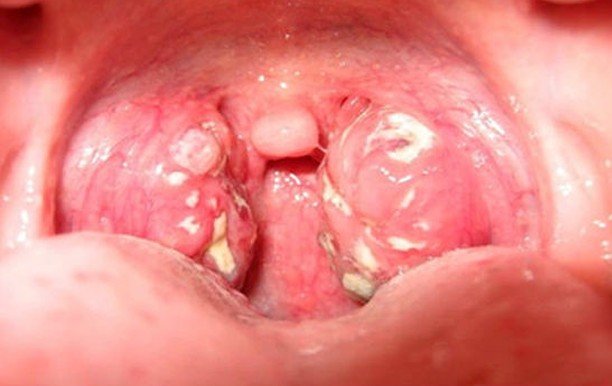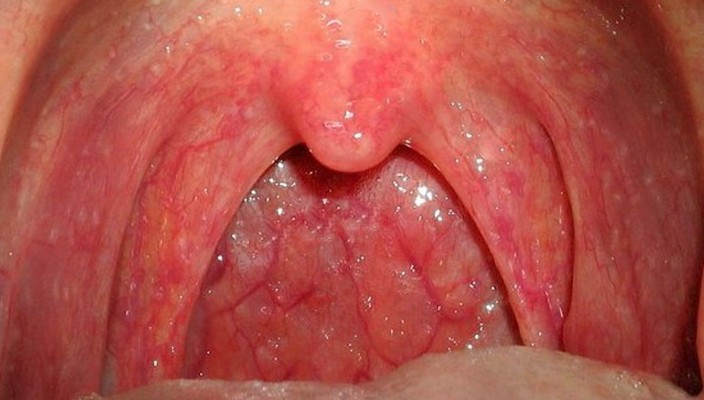Sore Throat on One Side
Last reviewed by Dr. Raj MD on January 12th, 2022.
Throat Hurts on One Side?
In the situation that you are suffering from a sore throat on one side, you might have inflamed tonsils (possibly with associated inflammation of the lymph nodes). In the majority of the cases, the sore throat is caused by a bacterial infection, most commonly with streptococcus. However, it can happen that such problems are caused by different viruses (viral infection). The important thing is that the type of infection is correctly diagnosed, so that the adequate treatment can be recommended.
Causes of Sore Throat on One Side
Tonsillitis
The tonsils exist in the throat for a purpose and that is to keep the bacteria or viruses from going further the respiratory tract. However, they are also present an increased risk for becoming infected, the associated inflammation causing a genuine discomfort.

If the tonsils are swollen on one side of the throat, the patient might experience difficulties swallowing. Upon examination, the tonsils will present a visible inflammation, with pus being visible with the naked eye (as white patches). Because of the infection, the patient might also present swollen lymph nodes and other systemic symptoms, such as fever, stage of general malaise and loss of appetite. Pain can appear when the patient tries to swallow, sometimes extending to the ear or the jaw.
In the majority of the cases, the inflammation of the tonsils is caused by a bacterial infection. The microorganism that often leads to such problems is streptococcus. However, it is possible that viral infections lead to the inflammation of the tonsils, some of the most common viruses including: Epstein-Barr virus, enterovirus, rhinovirus, parainfluenza virus, influenza virus or adenovirus.
When the tonsillitis is caused by a bacterial microorganism, the standard treatment is represented by antibiotics. In order to administer the right antibiotic, the doctor will take a sample from the throat and perform a bacterial culture. Upon identifying the bacteria responsible for the infection, the doctor can recommend a suitable antibiotic. The treatment has to be taken for as long as it is prescribed, otherwise the bacteria will develop resistance to the antibiotic. It is also customary for probiotic supplements to be administered at the same time with the antibiotic treatment, so to maintain a healthy gut microbiome.
If the infection is caused by a virus, anti-viral medication is going to be administered. Apart from the said treatment, it is recommended that one drinks plenty of fluids, in order to clear the infection and stay hydrated. Among the recommended fluids, there are water, unsweetened tea and clear sop. No caffeine-based drinks, alcohol or sugar, fizzy drinks should be allowed, as these can aggravate the symptoms, making swallowing even more difficult.
During the recovery period, it is important to rest as much as it is possible, as this can guarantee a rapid improvement of the experienced symptoms. Anti-inflammatory medication can also be administered, in order to bring relief from the symptoms. Among the recommended medication, there are acetaminophen, ibuprofen or naproxen. This medication can bring down the fever as well. Smooth foods can be introduced into the diet, as these are easier to swallow and they can be quite beneficial for the throat, especially when they are warm. Relief can be obtained from gargling with salt water, this natural remedy having disinfecting properties. The doctor might also recommend using a vaporizer or to suck lozenges, in order to recuperate faster from the infection and inflammation.
Pharyngitis
The symptoms of pharyngitis are often similar to the ones of tonsillitis, with the patients experiencing difficulties swallowing and also a scratchy feeling in the throat. It is important to remember that the inflammation of pharynx is also caused by infectious microorganisms, being easily transmitted from one person to the other. It is also more often diagnosed during the cold season, when the number of such infections are on the rise.

Apart from the actual sore throat, the patient will experience a lot of systemic symptoms. It is possible that a rash appears at the level of the skin, being accompanied by headaches and fever. If the infection is more severe, it is possible that the lymph nodes in the area become swollen. Apart from the above-mentioned symptoms, the patient might have achy joints or suffer from muscle pain, all of these leading to a state of general malaise.
In the majority of the situations, the inflammation of pharynx is caused by a viral infection. However, it is possible that bacterial infections also contribute to the appearance of such health problems. The most common bacterial microorganisms involved in the appearance of pharyngitis include streptococcus, chlamydia and gonorrhea.
When it comes to the treatment of pharyngitis, anti-viral medication can be administered. Antibiotics remain the standard treatment in the situation that the infection is caused by a bacterial infection. Anti-inflammatory medication is often administered for the symptoms, as they can reduce the fever and also the inflammation at the level of the pharynx.
In order to improve the symptoms, the patient can also consider natural remedies, such as gargling with salted water or drinking warm liquids (tea, soup). If you are drinking tea, you should consider adding lemon or honey to it, as this can have a genuinely beneficial effect at the level of the throat. Lozenges are recommended in order to improve the swallowing and sometimes a cold drink can help to numb the pain.
Strep throat
The strep throat can cause a genuine discomfort, even if it is present only on one side. Most patients suffer from the sore throat, feeling no interest in food and avoiding even liquids, due to the swallowing difficulties. Unfortunately, the strep throat can lead to a wide range of complications, such as rheumatism or kidney-related problems. This type of bacterial infection is commonly seen in children and teenagers, even though it can appear at any age.

When a person suffers from a strep throat, the tonsils can be swollen and red on one side of the throat. White pus can be seen at the level of the inflamed tonsils and the patient presents obvious swallowing difficulties. A rash can appear on the skin, the lymph nodes in the area can become swollen and a state of general fatigue can be present. The patient will present red spots on the roof of the mouth, with frequent stomach aches, characterized by nausea and vomiting. Because of the frequent vomiting, it is possible that the patient also suffers from dehydration.
The main cause behind the appearance of the strep throat is an infection with the streptococcus microorganism. Unfortunately, this bacteria presents a high level of contagiousness, being easily transmitted from person to the other, through sneezing or coughing. Touching contaminated objects, such as a napkin or a glass, can also lead to the transmission of the bacteria. The infection can also be transmitted via air, by touching a doorknob or by hand-to-hand contact.
The strep throat is mainly treated with antibiotics, after a bacterial culture has been performed. Patients are also advised to gargle with salted water, so as to disinfect their throats and eliminate the bacterial population. Drinking plenty of fluids is recommended, so to prevent the dehydration caused by vomiting. Because the dry air can aggravate the symptoms experienced by the patient, keeping a humidifier in the room in more than indicated.
Getting plenty of rest will allow the body to recover from the infection, especially if the problem has occurred in children or teenagers. Soft food is recommended as part of the diet, so as not aggravate the current swallowing difficulties. Patients are recommended to avoid foods that are spicy or acidic, as these can aggravate the sore throat as well. In the situation that the condition appears in children, it is recommended that they do not go to school, as the infection can be easily transmitted to other children.